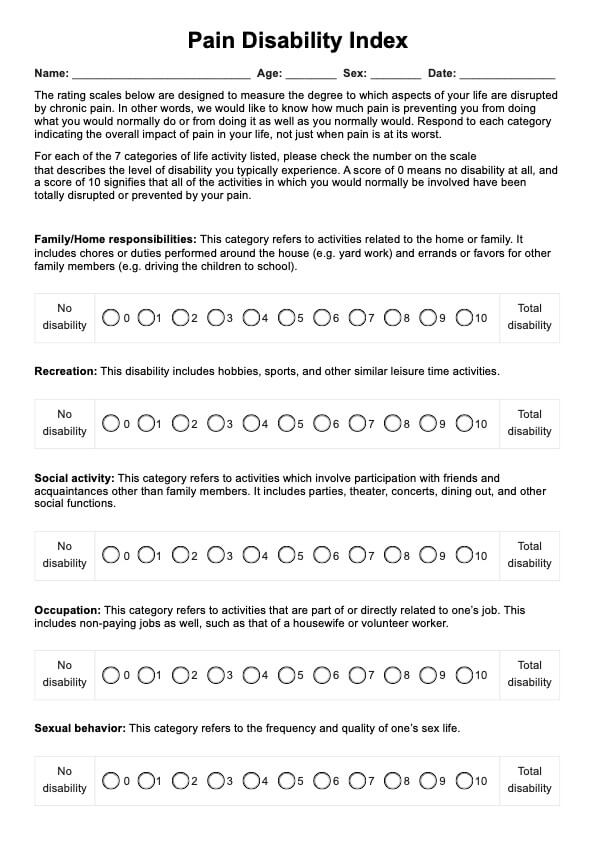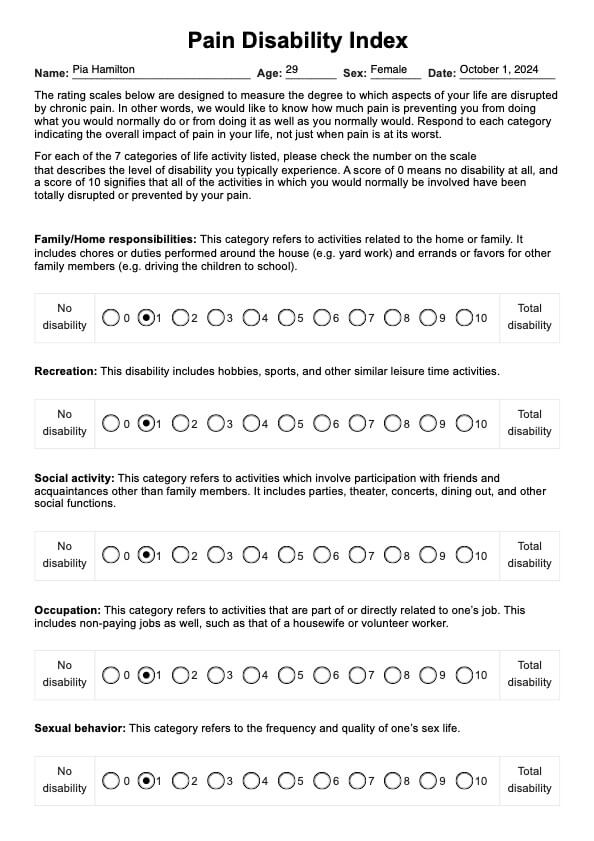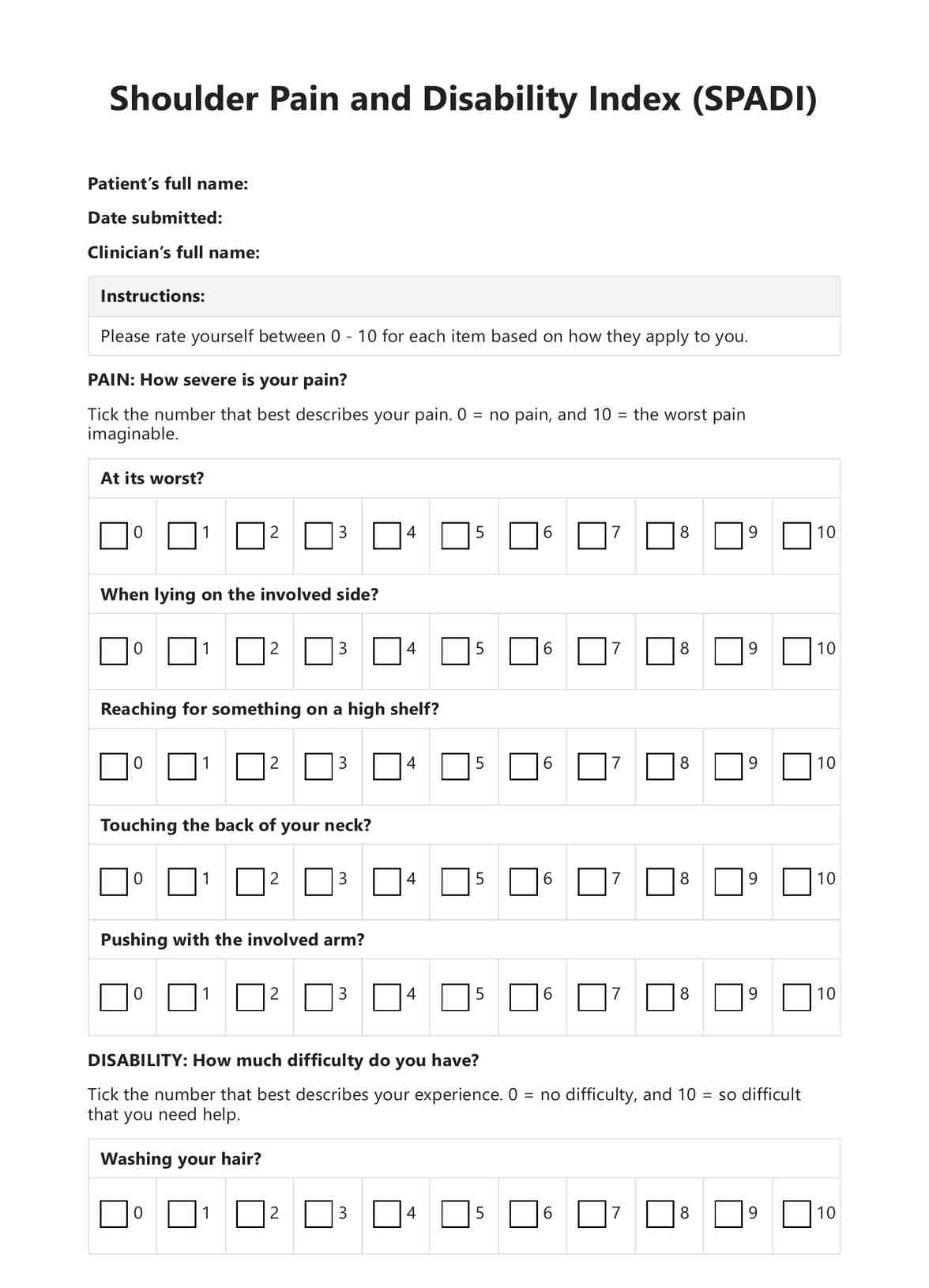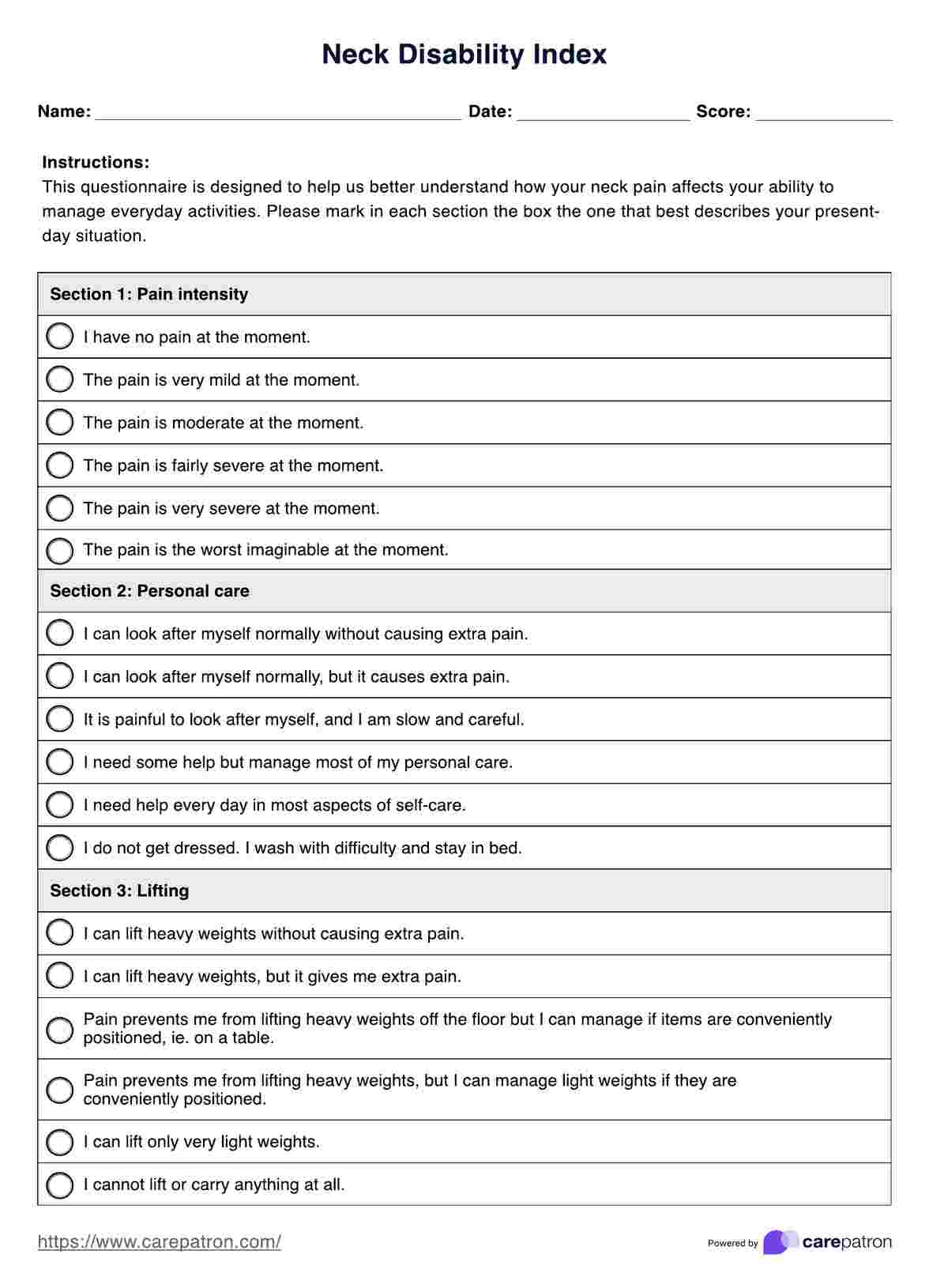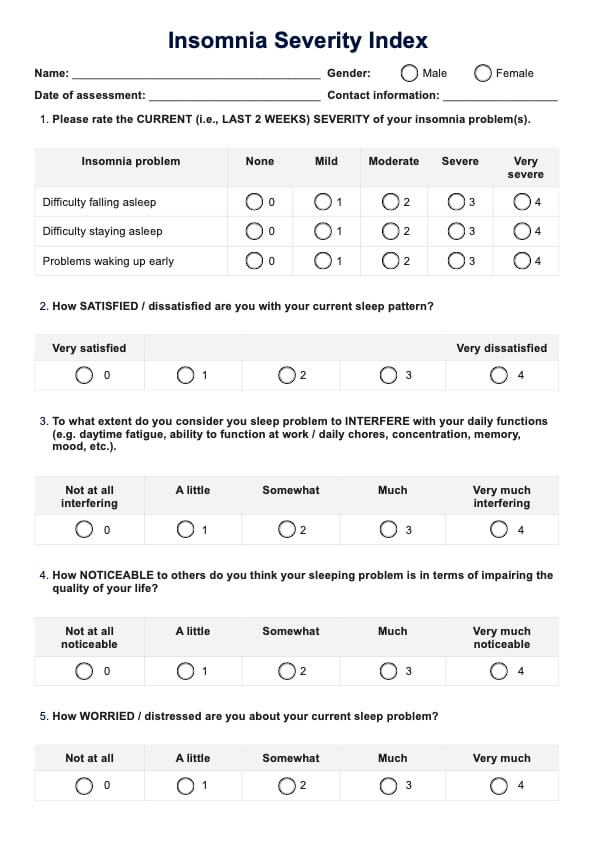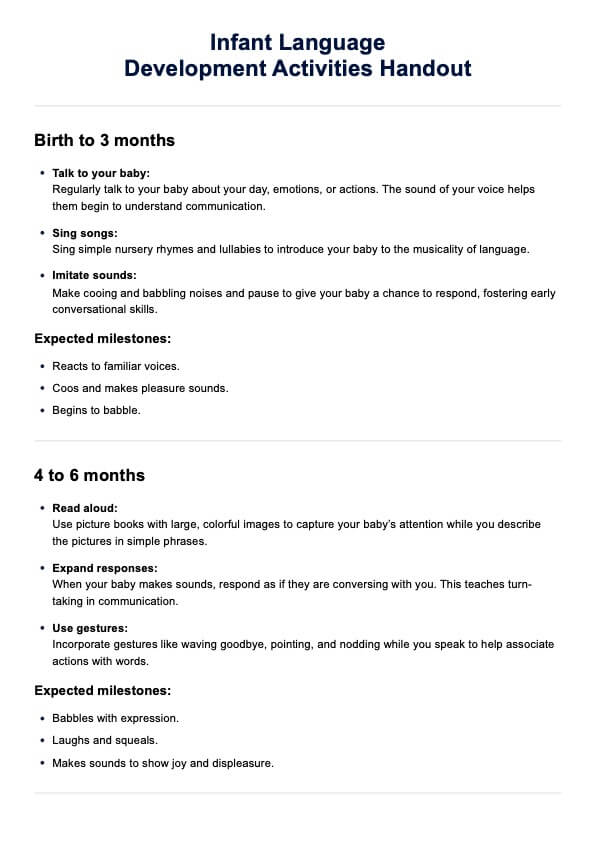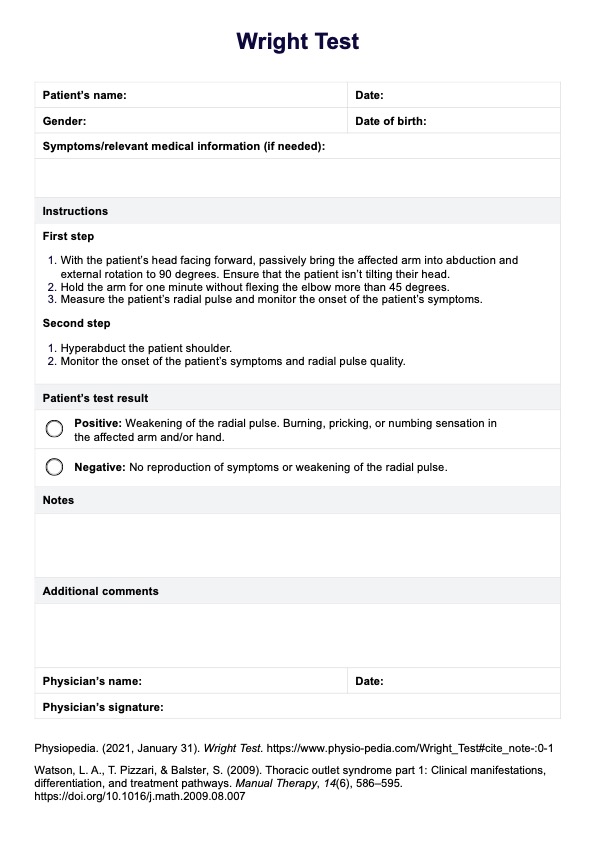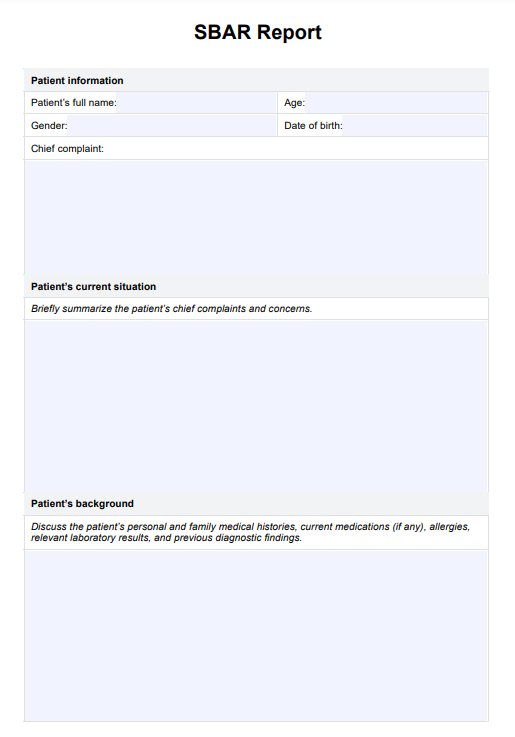Pain Disability Index
Learn about the Pain Disability Index and how it can help measure your patient's pain-related disability. Access a free PDF and example to help you get started.


What is Pain Disability Index?
Chronic pain can profoundly affect an individual's physical, psychological, and social well-being. On a physical level, chronic musculoskeletal pain can limit movement and mobility, leading to difficulty performing daily activities and physical decline due to inactivity.
Furthermore, chronic pain can hurt mental health; depression and anxiety are common in those who suffer from chronic pain. For example, chronic back pain can also make it difficult for individuals to interact with others and participate in activities they used to enjoy.
The Pain Disability Index (PDI) is a self-report questionnaire used to measure the level of disability caused by pain developed at St. Louis University Medical Center (Pollard, 1984). Unlike many measures focusing on pain intensity and duration, the PDI evaluates how pain interferes with various aspects of daily life, including family/home responsibilities, recreation, social activities, occupation, sexual behavior, self-care, and life-support activities. Each category is rated on a 0-10 scale, with 0 indicating no disability and 10 representing total disability (Tait et al., 1987).
In 1990, Tait et al. conducted two studies that demonstrate the validity of the Pain Disability Index as detailed in their paper The Pain Disability Index: Psychometric Properties. In the first study, the researchers discovered that patients with higher PDI scores are associated with greater psychological distress, more severe pain characteristics, and greater limitations in daily activities. The second study, on the other hand, indicated modest test-retest reliability for the index. The findings from both studies bolster the reliability and validity of the PDI as an effective, brief measure of pain-related disability.
By filling out the PDI questionnaire, patients can give their physicians a detailed picture of how chronic pain interrupts their lives.
Pain Disability Index Template
Pain Disability Index Example
How does this Pain Disability Index work?
This free Pain Disability Index template is simple. Here's how to get started:
Step 1: Access the free PDI
Using the link on this page, download a copy of the Pain Disability Index. You can also get it from the Carepatron app or the resources library.
Step 2: Provide a copy to your patient
Give the questionnaire to your patient and explain how it works. Use this to reassure them that you are concerned with their well-being and committed to finding the best treatment.
Step 3: Have your patient fill it out
Ask your patient to fill out the questionnaire. Tell them to rate how their pain has affected various aspects of their life on a scale of 0 to 10.
Step 4: Analyze the results
Once your patient has completed the questionnaire, review their responses and analyze them in conjunction with other information. This will help you determine the level of disability caused by chronic pain and design an effective treatment plan.
Pain Disability Index scoring and interpretation
The Pain Disability Index comprises seven categories: family/home responsibilities, recreation, social activity, occupation, sexual behavior, self-care, and life-support activities. Each category has a 0-10 scale, with 0 indicating no disability and 10 representing total disability.
The scores from each category are then added to get a total score. The range for the total score is 0-70, with 0 reflecting no disability and 70 reflecting the highest degree of disability. A higher score means a more significant disability due to pain.
Note that the Pain Disability Index is not a diagnostic tool but is used to measure disability due to pain. You should utilize it with other information to help you better evaluate your patient's pain levels.
When to use this Pain Disability Questionnaire?
The Pain Disability Index is useful for evaluating how much chronic pain affects the quality of life. You can use it if or when:
You want to understand your patient's level of disability due to pain.
The PDI can provide a clear picture of how chronic pain has impacted your patient's life and what areas they need help with. It can also give you a better sense of how to approach their treatment plan.
You want to measure the impact of palliative care.
You can use the Pain Disability Index to evaluate the effectiveness of palliative care. By assessing how much disability is caused by pain and monitoring changes over time, you can determine if the treatment is effective.
You need additional information about the effects of chronic pain.
The Pain Disability Index provides a detailed snapshot of how chronic pain affects different aspects of a person's life. This information can be valuable for designing an effective treatment outline. With the PDI, you can better understand your patient's needs, improving their health outcomes.
You need to provide evidence of disability.
The Pain Disability Index is a widely recognized tool for evaluating pain-related disability. The data it provides can be used to support a disability claim or as evidence of disability for other purposes.
Benefits of free Pain Disability Assessment
The PDI is a tool for medical professionals—including physicians, nurses, therapists, and social workers—in clinics, hospitals, and various settings to assess pain levels. Using the Pain Disability Index can provide several benefits, such as:
It provides an objective measure of disability due to pain.
This free Pain Disability Index can help you better understand how much pain affects your patient's life and what areas need to be addressed.
It's reliable.
The Pain Disability Index has been proven to be reliable and valid in research studies. You can be confident that the data you obtain is accurate and can be used for decision-making.
It's easy to use.
This free Pain Disability Index template is fully digital and easy to use. You can quickly fill out the questionnaire, score it, and provide your patient with the results.
It's highly versatile.
You can use the Pain Disability Index in various settings and with different patient populations. You can use it to assess pain levels in both children and adults. Additionally, it can be used for research purposes or to provide evidence of disability for other purposes.
References
Davies, C. C., & Nitz, A. J. (2009). Psychometric properties of the Roland-Morris Disability Questionnaire compared to the Oswestry Disability Index: a systematic review. Physical Therapy Reviews, 14(6), 399–408. https://doi.org/10.1179/108331909x12540993898134
Pollard, C. A. (1984). Preliminary validity study of the pain disability index. Perceptual and Motor Skills, 59(3), 974–974. https://doi.org/10.2466/pms.1984.59.3.974
Tait, R. C., Chibnall, J. T., & Krause, S. (1990). The pain disability index: Psychometric properties. Pain, 40(2), 171–182. https://doi.org/10.1016/0304-3959(90)90068-o
Tait, R. C., Pollard, C. A., Margolis, R. B., Duckro, P. N., & Krause, S. J. (1987). The pain disability index: Psychometric and validity data. Archives of Physical Medicine and Rehabilitation, 68(7), 438–441.
Commonly asked questions
The Pain Disability Index is a 7-item questionnaire scored on a 0-10 point scale. To calculate the total score, add the scores of each item. The resulting score will give you an indication of how much disability is caused by pain.
Chronic musculoskeletal disorders are long-lasting conditions affecting muscles, bones, and joints, such as arthritis or chronic back pain. They can lead to ongoing pain, stiffness, and reduced movement, making it difficult for patients to perform daily activities and impacting their overall quality of life.
Other pain disability questionnaires are essential for evaluating functional limitations caused by pain. The Oswestry Disability Questionnaire or Index (ODI) is used for measuring permanent functional disability related to low back pain, especially for patients with severe disability. Similarly, the Roland-Morris Disability Questionnaire (RMQ) features 24 items that assess disability levels and is most sensitive for those with mild to moderate disability (Davies & Nitz, 2009). Additionally, the Brief Pain Inventory (BPI) offers a rapid evaluation of both pain severity and its impact on functioning.


